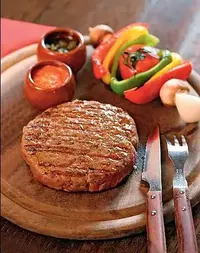The serbian

The history of Serbia dates back a century. Back in the VI century, the ancestors of modern Serbs Slavic tribes decided to settle on the western lands of the Balkan Peninsula.
In the Middle Ages, the Serbian state occupied a leading position in the region and extended almost the entire territory of the western Balkans. Serbian cuisine and its culinary traditions began to emerge in those days.
Most of the diet of the Serbs in the Middle Ages was meat dishes prepared according to the recipes of Serbian cuisine, dairy products, bread, vegetables. Serbian cuisine is characterized by the use of specific seasonings and spices. For example, not a single dish of Serbian cuisine will do without black pepper, and parsley is added to Serb soups.
In addition to greens and peppers, spices such as paprika or red pepper, white pepper, coriander, bay leaf, cloves and garlic are used as condiments in Serbian cuisine. Serbian recipes often mention garlic, which gives dishes a specific taste and smell.
National Serbian cuisine is similar to the culinary traditions of its neighbors in the Balkan region. Bulgarian cuisine influenced Serbian cuisine and Serbs began to use fresh vegetables everywhere when preparing salads or dishes from stewed, boiled and baked vegetables.
Like Bulgarians, the people of Serbia love meat dishes based on pork, lamb and poultry. Fish dishes in Serbian cuisine occupy a special place. Bulgarian cuisine has taken root so much in Serbia that the same dishes in Serbian are called the same as in Bulgarian, so as not to get confused.
By the middle of the 15th century, the territories of the Serbian state were conquered by the Turkish Khanate. This period of development of the Serbian culinary tradition took place under the auspices of Turkish culture and cuisine. Best of all, the Serbs adopted the traditions of made Turkish sweets, which even now you can easily buy in pastry shops.
Serbian cuisine and Hungarian are similar in that chefs often use Smalec when preparing dishes. This is pork fat, which is fried and added to soups. There are only two types of soups for Serbs. Regular soup, which is called supa, and čorba - this soup is made based on broth, to which toasted flour is added.
Serbian cuisine is thought to be beyond thought without such an important ingredient as Kaimak. The Serbs came up with a special process in which milk is boiled, and then it is allowed to cool down in special plates.
When the milk cools, a milk film is formed, which is collected and placed in layers in special wooden barrels. Sometimes the Kaymak layers are salted a little to improve taste. Milk films begin to roam.
The longer Kaymak wanders, the tastier it will eventually turn out. Kaymak is served as a savoury snack or added when preparing Serbian cuisine. Serbian cuisine is popular not only for Ražnić kebab, whose meat is cooked on charcoal.
The pride of Serbian culinary experts is the minced meat cutlets Čevapčmčm and Pleskavica. Cutlets are also roasted on charcoal, and then served with finely chopped onions and hot pepper pods.
Serbs have been baking their traditional bread for centuries, which serves as an indispensable attribute of any Serbian meal, and has also been used in religious rites and rituals. In ancient times, it was believed that it was sinful to throw away bread, so kvass was made from bread.
Any Serbian pie is called Pita. True, do not think that pies will be made of fresh dough, like Greek Pita. Unleavened bread sounds like Somun in Serbian. And Serbian pies can be stuffed with fruit, vegetables, meat or fish.
 Español
Español Français
Français Português
Português Русский
Русский 简体中文
简体中文 繁體中文
繁體中文 日本語
日本語 한국어
한국어 العربية
العربية Türkçe
Türkçe Қазақ
Қазақ Deutsch
Deutsch Italiano
Italiano Українська
Українська
